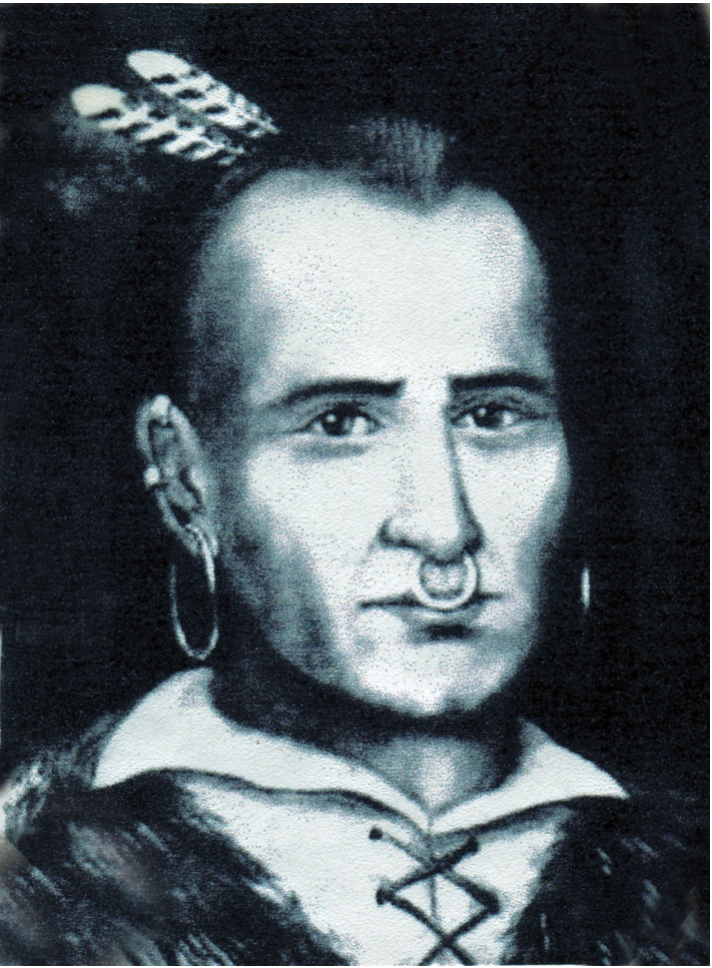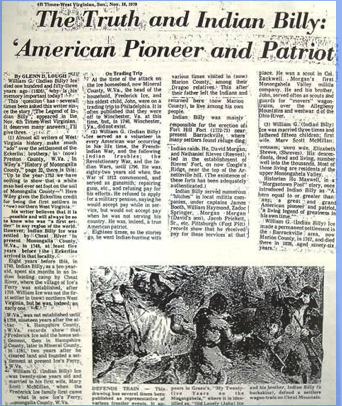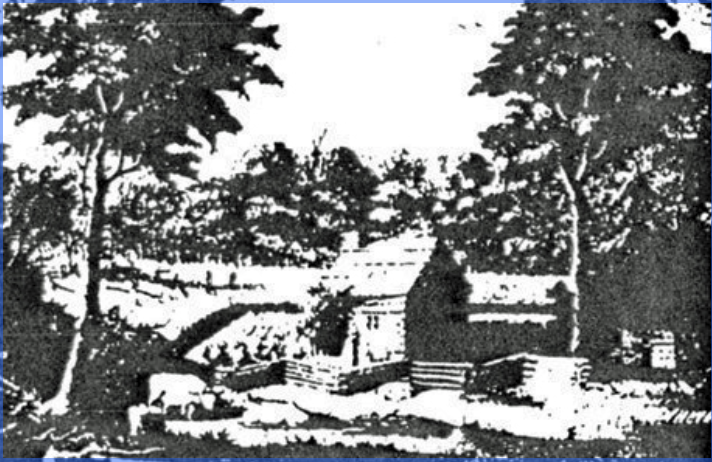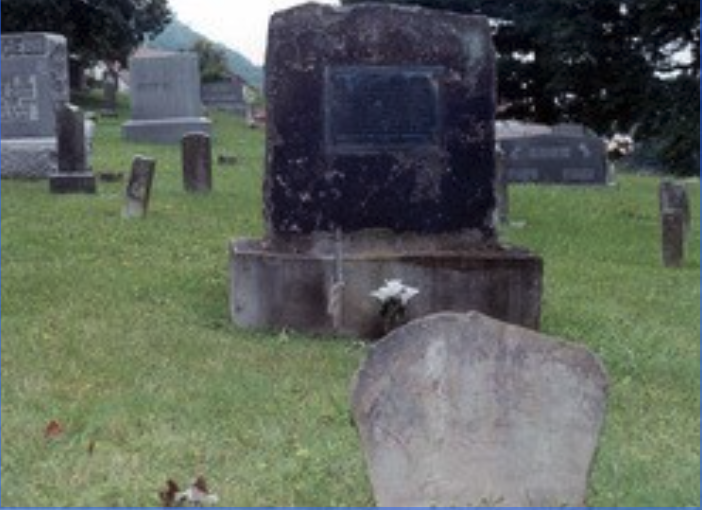
Although this story does not take place in Doddridge County, it does take place in our sister counties. Many descendants of the William “Indian Billy” Ice family now live in Doddridge, Tyler, and Ritchie County. For that reason, I felt it worthy of publication, but cannot verify all of its contents.
William Galloway Ice was born, the second son of Frederick Ice and Mary Galloway, on the 1st of April, in 1730. The family was living in the South Branch of the Potomac River in Patterson Creek, Hampshire County, Virginia. This area would later become part West Virginia. William was also a colorful character and the father of most of the modern-day Ice families in the United States, mostly because he was the father of 17 children with three different wives.
After a year with a remarkably good crop, when William was about ten years old, Frederick Ice and several of the men from the town went to the mill. They had a long distance to go, probably to Winchester, Virginia, which at the time was the center of trade for north-eastern Virginia. When they returned to the settlement, they found the Mohawk Indians had raided it, and killed or taken the inhabitants, burned the homes, destroyed the crops, and driven off the livestock. Frederick found the ashes of his home to discover his wife, Mary, and three of his children were captured by the Indians. These children were Christine, William, and Mary. Mary stayed the remainder of her life with this Indian tribe, and only visited the Ice family once afterward, in 1825. Although untrue, she is mentioned in several places as the mother of Tecumseh. Christina married an Indian, had three children with him, and died naturally at age 25. The only member of Frederick’s family to come home was William.

During this time, William was sold to the Shawnee Indians. William tried to escape from the Native Americans several times but was caught, brought back into the Ohio Native towns, and the top of his ears were cut off flat for his attempts. These Native towns are near modern Chillicothe, Ohio. In her book, Virginia Ice Conaway wrote about William’s time at these Native camps.
I have heard my father, T. F. Conaway, tell how his granduncle Bill Ice, as they called him, escaped from the Indians. He (Indian Billy) said that the Indians were away out beyond the Ohio River and once they started on a trail through the woods took him and one of the young Indian boys along. Eventually, they stopped and left most of their horses for him and this boy to take care of. He and Indian Boy got into a fight and he got the best of the Indian in the fight. Then he went into the wigwam. “I did not like the look the boy gave me and decided to leave. The horses were together near camp and I took a horse and followed the trail of the Indians who had left us, and in a few miles, found myself opposite a town. I swam my horse across the river and fastened it in the bushes and walked into Pittsburg. A white man was sitting in the street and asked me if I was a prisoner of the Indians. I said that I was. He told me ‘if you want to escape, go into the house and stay until the Indians leave town. I will take care of you.’ I told this man where I left my horse. He gave me food clothes to wear. I had worn Indian clothes while I was with them. I could talk English learned from other prisoners. I worked awhile in Pittsburg, then went to Canada and stayed awhile. From Canada, I went to Paris, France, and then came back to America, landing in Philadelphia just as they were getting to cut the Mason and Dixon line. I joined and worked with them until I can to Ice’s Ferry. My stepmother was talking to one of the men who belonged to the camp and told her they had a man who had been with the Indians. She took me home and Father found that Brother John was still with the Indians and arranged to bring him home.
She later wrote about how Indian Billy had been in Philadelphia for years, and Frederick had been there many times during those years, but they passed each other without knowing who the other was. Eventually, however, most of the family was reunited. The trauma they experienced was not isolated or unheard of in their day. There were many struggles between Native trying to hold onto their ancestral land and prevent turning their people into refugees, and the Europeans moving west to create a new life for themselves and their families.
Indian Billy knew he had been lucky to have his life, and he did not waste a moment of it. He fought in the Revolution with the Virginia militia of Prickett’s Fort in Mongolia County (now Marion County, West Virginia). Indian Billy received pay at Fort Pitt, Pennsylvania, and was on the payroll list at General Braddock’s defeat during the French and Indian War. He was also the first to settle Barrackville in Marion County. The 1785 record of survey shows him owning 400 acres on both sides of the Buffalo Creek there. He later surveyed and settled an additional 56 acres in the same area.
During his time on the Mason and Dixon line, Indian Billy worked as a laborer. Cutting this line had been difficult. It was started in 1763 but stopped. Again, it started in early June 1766, and reached the top of the Allegany Mountains. On June 17, 1767, the again started west in Somerset County, Pennsylvania, and pushed on to the Monongahela River in October. He also worked as an interpreter during his time on the line and in the French and Indian War. However, during his life he could neither read or write, and he did not know the English alphabet.
The next photo was submitted by an “Awhile Ago Times” subscriber and was identified as a photo of the pioneer home of William “Indian Billy” Ice in the 1780’s in the present Barrackville area. I apologize for the poor quality. I searched but could not find a clearer copy.

William “Indian Billy” Galloway Ice died in April of 1826. He wrote a will:
In the name of God, Amen. I, William Ice of Buffalo Creek, Monongalia County, and the State of Virginia, being very sick and weak in body of perfect mind and memory thanks be given to God.
Calling into mind the mortality of my body and knowing that it is appointed for all men once to die, do make and ordain this my last will and testament that is to say, principally and first of all give and recommend my soul to Almighty God who gave it, and my body I recommend to the earth to be buried in decent Christina burial at the discretion of my wife.
Nothing doubting but at the general resurrection I shall receive the same again by the Mighty power of God and as touching such worldly estate wherewith it has pleased God to bless me in this life I give, devise, and dispose of all the same in the following manner and form.
First: I give and bequeath to my wife Elizabeth Ice all my household goods and debts.
I give and bequeath to my loving wife Elizabeth Ice all my land as long as she lives and keeps my name, and if she alters my name then only her thirds.
I give and bequeath to my wife Elizabeth Ice all my horses, cattle, sheep, and hogs and farming utensils.
I give and bequeath to my son Thomas Ice fifteen shillings.
I give and bequeath to my son John Ice fifteen shillings.
I give and bequeath to my son William Ice ten dollars.
I give and bequeath to my son George Ice fifteen dollars.
I give and bequeath to my son Abraham Ice fifteen dollars.
I give and bequeath to my son Adam Ice fifteen dollars.
I give and bequeath to my daughter Margaret Bayles fifteen shillings and I give and bequeath to my daughter Mary Shrieves fifteen shillings, and to my daughter Eve Shrieves fifteen dollars, none of these heirs to be paid till Benjamin Ice my youngest son comes of age.
I give and bequeath unto James Ice and Frederick Ice and Benjamin Ice all my land to be equally divided quantity and quality James to first choice, Frederick second choice, and Benjamin the last choice, and these three boys to pay my daughter Sally Ice one hundred dollars apiece.
I continue make and ordain my loving wife Elizabeth Ice my sole executrix of this my last will and testament by them freely enjoyed.
And I do hereby utterly disallow, revoke, and disannul all and every other former testament in witness whereof I have hereunto set my hand and seal this Fourth of July 1818.
X (William’s Mark)
Three people served as witness to this will, but it was contested by the children of William’s first and second marriages against the children of the third marriage. The allegations being that William was too old and feeble of mind to properly decide his bequeaths. Many of William’s acquaintances testified on behalf of the defense as to his ability to make sound judgments. However, in the final outcome the prosecution prevailed. On September 17, 1829, the Superior Court of Chancery held at Clarksburg, Virginia, gave the prosecution a victory under the presiding judge, Judge Henry St. George Tucker.
The grave of William is located in the Ice Cemetery on Barrackville Highway. It is marked by the Ice Family Association today.

The cemetery is near Barrackville on US 290. It was established in 1830 or earlier as a private burial ground. Later, in 1881, it was included in property of a Church of Christ. It is fenced and not landscaped. It is considered in fair condition and most lots are marked by corner stone. No burial records were kept for this cemetery, but the earliest stone was marked 1830. It contains 15 graves marked by small, flat, unlettered field stones. Tradition holds these are graves of members of the Fortner and Bayles families, along with many others. Three Civil War and one World War veteran are buried there. In total, there are 119 marked graves and unknown unmarked graves. In 1929, the Ice Family Association erected a native stone monument at the site of William’s grave, with a bronze tablet inscribed: “WILLIAM ICE 1725-1830, KNOWN AS “INDIAN BILLY” FROM THE FACT THAT HE WAS CAPTURED BY THE INDIANS WHEN A CHILD. AFTER HE RETURNED TO CIVILIZATION, HE PATENTED 600 ACRES OF LAND. THIS CEMETERY AND THE WESTERN PART OF BARRACKVILLE, W.VA. ERECTED BY THE ICE FAMILY ASSOCIATION.”
It was said that “Indian Billy” was a kind and gentle man, with a mischievous personality. He enjoyed growing a large pumpkin field, and then helped the neighbor children steal his own pumpkins.
Just as many in this and the surrounding counties are, my husband is a relative, the g-g-g-grandnephew of William “Indian Billy” Ice. So, you can understand my interest in it.
This article was posted on the History and Novelty website in 2014 by “LIZZIE 3622” at: https://historyandnovelty.wordpress.com/2014/07/22/william-galloway-ice-he-was-called-indian-billy/. I want to give her and the website full credit for this amazing and interesting article.
Until next time, God bless & always remain humble.
Patricia Richards Harris

